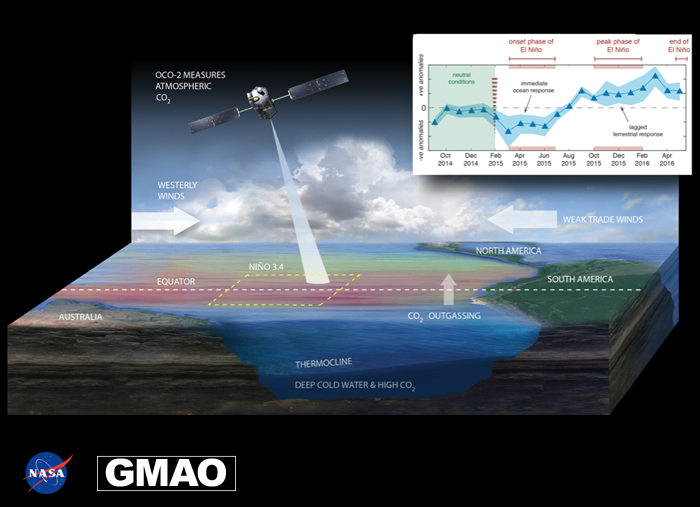NASA's OCO-2 mission tracks the influence of El Niño on atmospheric CO2
El Niño and its cold counterpart La Niña (collectively known as the El Niño Southern Oscillation or ENSO) are the dominant modes of tropical climate variability. ENSO originates in the tropical Pacific Ocean but spurs a variety of anomalous weather patterns around the globe. Not surprisingly, it also leaves an imprint on the global carbon cycle. Understanding the magnitude and phasing of the ENSO-carbon cycle relationship has important implications for improving the predictability of carbon-climate feedbacks. On July 2, 2014, NASA launched the Orbiting Carbon Observatory-2 (OCO-2) mission to measure global atmospheric carbon dioxide (CO2) with the precision, resolution, and coverage necessary to quantify regional carbon sources and sinks. The timing of the launch of the OCO-2 mission was extremely fortuitous as within the first two years of its operation, a major El Niño occurred – the 2015-2016 El Niño, which was one of the strongest events ever recorded.

NASA’s OCO-2 mission monitored changes in global atmospheric CO2 concentrations during the 2015-2016 El Niño event.
The inset shows the time-series of column-averaged CO2 concentration anomalies derived from OCO-2 observations over a region in the tropical Pacific Ocean.
During neutral conditions, the anomalies hover around zero but during the El Niño event, two distinct phases are visible — a negative phase during the El Niño onset (March – July 2015) and a positive phase during the El Niño peak (October 2015 and later).
Negative phase anomalies are due to the reduction in sea-to-air CO2 fluxes from the tropical Pacific while the positive anomalies occur due to the response of the land carbon cycle.
» Click for PDF «
The high-density observations from OCO-2 provided us with the opportunity to study how the global carbon cycle responded to the El Niño event. By analyzing trends in the time series of atmospheric CO2, we saw clear evidence of a two-phased response - an initial decrease in CO2 concentrations over the tropical Pacific Ocean, specifically during the early stages of the El Niño (see figure inset - March through July 2015) followed by a rise in CO2 concentrations during the later stages of the El Niño (see figure inset — October 2015 onwards). While the first phase of the response is due to a reduction in CO2 outgassing from the tropical Pacific Ocean, the second phase of the response is due to the terrestrial component of the carbon cycle – a combination of reduction in biospheric uptake of CO over pan-tropical regions and an enhancement in biomass burning emissions over Southeast Asia and Indonesia.
For more details on this topic, see the full article published in Science: http://dx.doi.org/10.1126/science.aam5776
Reference
A. Chatterjee et al., Science, 358, eaam5776 (2017). DOI: 10.1126/science.aam5776

